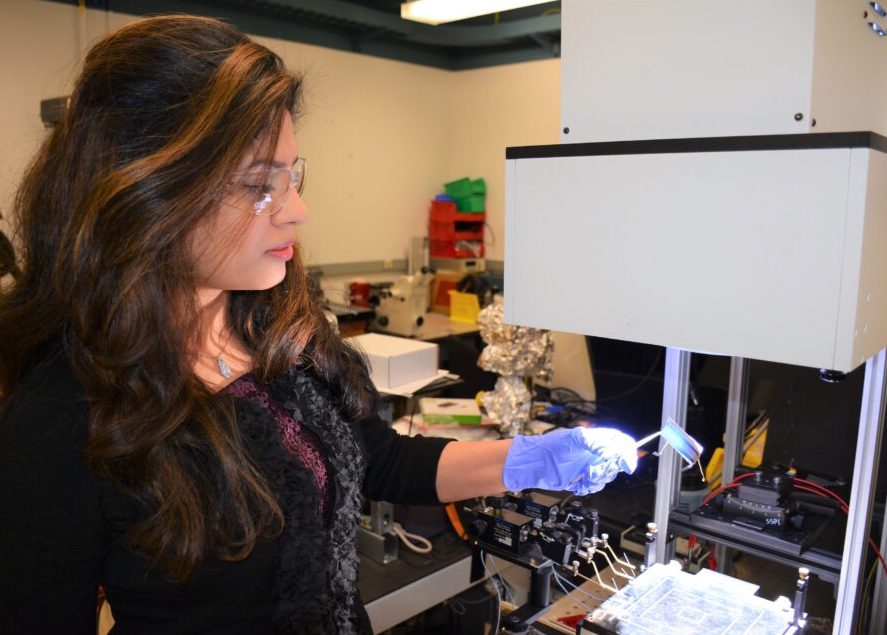Researchers atStanford Universityhave used 3D printing to develop a novel device that could help boost solar arrays’ energy-capturing capabilities and remove the need for mechanized tracking systems.
Shaped like a tipless inverted pyramid, the team’s Axially Graded Index Lens (AGILE) device captures over 90% of the light it’s exposed to and funnels it in a way that trebles its brightness. Compared to existing solar arrays, which follow the sun across the sky, the AGILE can also catch light passively from any angle, lending it the potential to help make solar panels smaller, cheaper, and more efficient.
该设备的开发人员Nina Vaidya解释说:“我们想创建一些可以亮相的东西,并将其集中在相同的位置上,即使源变化了方向。”“这是一个完全被动的系统 - 它不需要能量来跟踪源或具有任何活动部件。如果没有移动位置或需要跟踪系统的光学焦点,则集中光变得更加简单。”

Pursuing solar power efficiency
Seeing as photovoltaic systems’ sunlight-absorbing capabilities are dependent on them directly facing the sun, many are fitted with solar trackers. In a single-axis set up, these systems rotate back and forth in a single direction. With dual-axis trackers, on the other hand, they tend to use a mirror to redirect sunlight towards a stationary receiver, as a means of maximizing light-panel exposure.
Both of these ‘active’ systems move in tandem with the sun, and generate more energy than stationary alternatives, but according to the Stanford engineers, they’re also pricier and more complicated to build. To facilitate the more efficient capture of solar energy, the team has therefore come up with a device made from a material that’s designed to passively concentrate scattered light at a focal point.
Known as AGILE, this device operates like a magnifying glass, in that it focuses the sun’s rays into a smaller, brighter point, but instead of moving with the sun, it channels rays from all angles to the same output. By replacing the silicon used to encapsulate existing solar modules with a layer of these devices, the researchers say it’s possible to generate more energy from cheaper, compact solar panels.
“The best solutions are often the simplest of ideas,” explains Vaidya’s doctoral advisor Olav Solgaard. “An ideal AGILE has, at the very front of it, the same refractive index as the air and it gradually gets higher – the light bends in a perfectly smooth curve.” Though he adds, “in a practical situation, you’re not going to have that ideal AGILE.”

AGILE solar energy capture
In order to produce their initial AGILE polymeric lens prototypes in 2018, the engineers used a combination of SLA and wax 3D printing. However, the team has since moved on to a method that enables the deposition of glass and polymer into a graded index material, with layers capable of changing a light beam’s direction in steps, instead of in a smooth curve.
Utilizing this material, the researchers have now managed to create ‘mirrored’ devices, in which any light heading in the wrong direction, is bounced back towards their output. During testing, these prototypes have also demonstrated the ability to channel light in such a way that it trebles its brightness. As such, it’s said that the devices could eventually be fitted to ordinary solar panels, as a means of enabling them to capture light scattered by the Earth’s atmosphere, weather and seasons.
根据Vaidya的说法,创建此类设备的主要挑战是制定正确的材料。用来使团队原型的塑料和玻璃必须彼此兼容,好像一个人以与另一个不同速度不同的热量而扩展,整个设备可能会破裂。也就是说,该团队最终遇到了一个公式,该公式允许创建具有纳米尺寸功能的镜头,借出了太阳能电池板存储和背光显示功率的潜力。
“To be able to use these new materials, these new fabrication techniques, and this new AGILE concept to create better solar concentrators has been very rewarding,” concludes Vaidya. “Abundant and affordable clean energy is a vital part of addressing the urgent climate and sustainability challenges, and we need to catalyze engineering solutions to make that a reality.”
“即使某些试验没有锻炼,利用我们的努力和知识来建立有意义的工程系统也是我的驱动力。”

Advancing solar energy storage
目前,正在使用具有增强的太阳能能源能力的3D可打印材料进行大量研究。今年早些时候,Oak Ridge National Laboratory(ORNL)宣布,一支研究人员正在调查金属卤化物钙钛矿的潜力3D printing high-performance solar batteries。
Similarly, start-up T3DP has previously experimented with using its patented technologies to3D打印基于钙钛矿的太阳能电池板。据说,该公司以苍蝇眼的精确复制品进行了建模,据说该公司的铜垫脚手架能够利用两倍的能量,是传统太阳能电池板的两倍。
Elsewhere, the technology has also been deployed to enable the creation of solar-powered devices with other applications than clean energy generation. Researchers based in China and Singapore, for example, have3D打印的太阳能水净化设备at such a high standard in the past, that they’ve metWorld Health Organizationstandards.
The researchers’ findings are detailed in their paper titled “3D打印的光学元件带有纳米尺度表面粗糙度,” which was co-authored by Nina Vaidya and Olav Solgaard.
To stay up to date with the latest 3D printing news, don’t forget to subscribe to the3D打印行业newsletter或跟随我们Twitter或喜欢我们的页面Facebook。
For a deeper dive into additive manufacturing, you can now subscribe to ourYoutubechannel, featuring discussion, debriefs, and shots of 3D printing in-action.
Are you looking for a job in the additive manufacturing industry? Visit3D Printing Jobs选择的角色。
Featured image shows Nina Vaidya measuring the experimental performance of optical concentrators under a solar simulator. Photo via Nina Vaidya.



